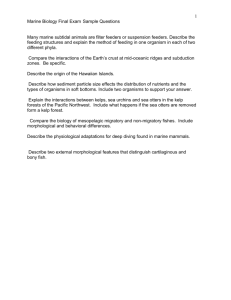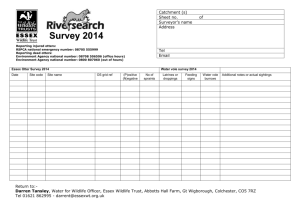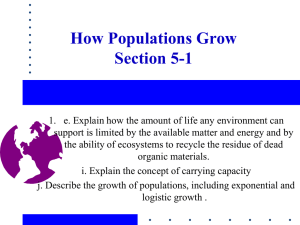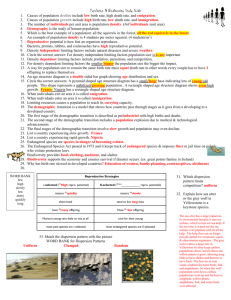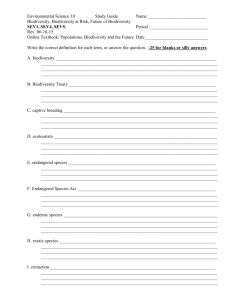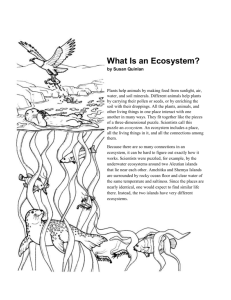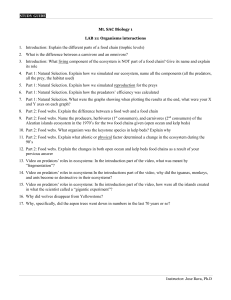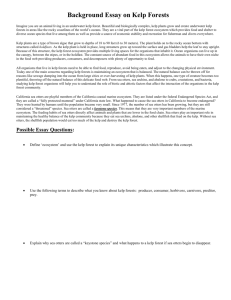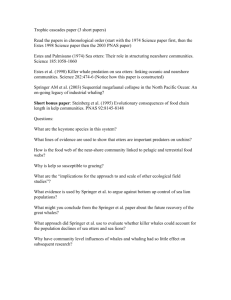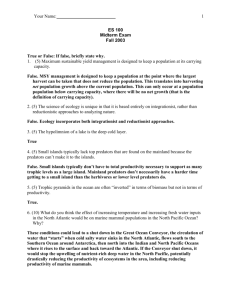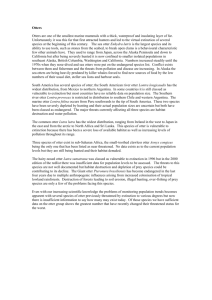Ecosystem Pretest/Post Test
advertisement
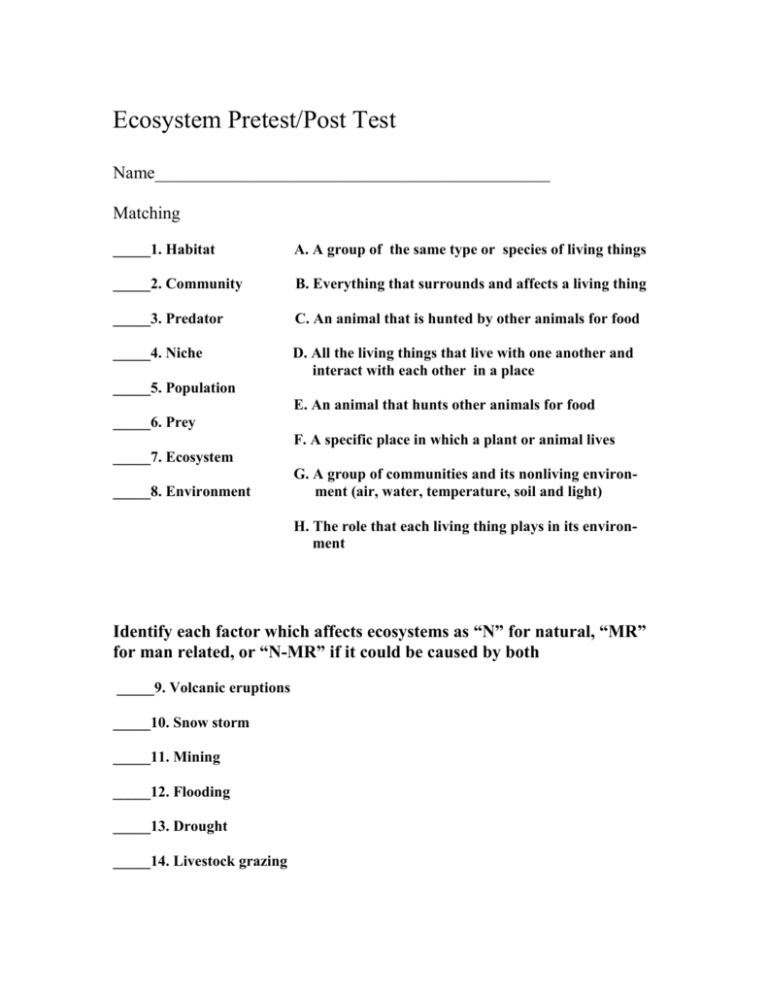
Ecosystem Pretest/Post Test Name_____________________________________________ Matching _____1. Habitat A. A group of the same type or species of living things _____2. Community B. Everything that surrounds and affects a living thing _____3. Predator C. An animal that is hunted by other animals for food _____4. Niche D. All the living things that live with one another and interact with each other in a place _____5. Population E. An animal that hunts other animals for food _____6. Prey F. A specific place in which a plant or animal lives _____7. Ecosystem _____8. Environment G. A group of communities and its nonliving environment (air, water, temperature, soil and light) H. The role that each living thing plays in its environment Identify each factor which affects ecosystems as “N” for natural, “MR” for man related, or “N-MR” if it could be caused by both _____9. Volcanic eruptions _____10. Snow storm _____11. Mining _____12. Flooding _____13. Drought _____14. Livestock grazing _____15. Human hunting or fishing _____16. Logging _____17. Hurricanes _____18. Tornadoes _____19. Predation Circle the correct choice In a stable ecosystem, an increase in the numbers of prey for a specific predator would generally result in a decrease / increase in the number of its predators. In a stable ecosystem, a decrease in the numbers of prey for a specific predator would usually result in a decrease / increase in the number of its predators. Write a response An alien predator has been introduced into the otter’s kelp forest ecosystem. It preys only on sea urchins. What do you think will happen to the abalone and the sea urchin populations that live in the kelp forest and the kelp forest itself? ________________________________________________________________________ ________________________________________________________________________ ________________________________________________________________________ ________________________________________________________________________ ________________________________________________________________________ ________________________________________________________________________ ________________________________________________________________________ ECOSYSTEMS VOCABULARY A group of the same type or species of living things. Everything that surrounds and affects living things. An animal that is hunted by other animals for food. All the living things that live with one another and interact with each other for food . An animal that hunts other animals for food. A specific place in which a plant or animal lives. A group of communities and its nonliving environment (air, water, temperature, soil, and light). The role that each living thing plays in the environment. WINTER STORMS CARRY OTTER PUPS OUT TO SEA WHERE THEY DROWN. (LOSE 2 SEA OTTER PUPS) AN ANGRY ABALONE FISHERMAN SHOOTS A MOTHER OTTER KILLING IT. ITS OTTER PUP, UNABLE TO FEND FOR ITSELF, STARVES TO DEATH. (LOSE A MOTHER SEA OTTER AND HER PUP) DISEASE OF AN UNKNOWN CAUSE, POSSIBLY POLLUTION, KILLS ½ OF YOUR OTTER POPULATION. (LOSE ½ OF YOUR SEA OTTER POPULATION) CALM SEAS AND ABUNDANT FOOD ALLOW FEMALE OTTERS TO SUCCESSFULLY CARE FOR THEIR YOUNG. (ADD 1 SEA OTTER PUP FOR EACH FEMALE SEA OTTER) HUMAN OVERFISHING HAS REDUCED FISH STOCKS TO THE POINT THAT THEIR NATURAL PREDATORS SUCH AS SHARKS AND KILLER WHALES MUST NOW KILL SEA OTTERS TO SURVIVE. (LOSE 2 SEA OTTERS) TRAWLERS DRAG NETS ACROSS THE OCEAN BOTTOM TO CATCH FISH AND SHELL FISH WHICH LIVE ON THE BOTTOM. DISTURBANCE OF SEA BED SANDS CAUSE SHELL FISH TO DIE. SEA OTTERS BEGIN TO STARVE. ( LOSE 2 SEA OTTERS) THE OTTERS’ KELP FOREST IS SET ASIDE AS AN ECOLOGICAL PRESERVE CLOSED TO FISHING AND HUMAN ACTIVITY. (OTTER MOTHERS SUCCESSFULLY RAISE 1 PUP EACH) AN OTTER DIES OF NATURAL CAUSES. (LOSE 1 SEA OTTER) SEA OTTER DESCRIPTION: * A marine mammal * Weighs between 45 and100 pounds * Brown fur DIET: * Sea urchins, sea stars, crabs, clams, snails, mussels, abalone NATURAL PREDATORS: Sharks, killer whales NICHE: Maintains stability of the kelp forest by keeping seaweed predators in check HABITAT: Kelp Forest canopy ABALONE DESCRIPTION: * Gastropod mollusc, one shelled animal * An invertebrate * Has 1 muscular foot * Inside of the shell is known as “Mother of Pearl“ * The red abalone can grow up to 12” across DIET: Seaweed NATURAL PREDATORS: Fish, eels, crabs, octopi, sea stars, sea otters NICHE: Helps control growth of the kelp HABITAT: Kelp Forest floor SEA URCHINS DESCRIPTION: Echinoderm *Is covered with spines that may have poison glands *Has many tubelike feet between the spines * Some types can be 10” across from spine tip to spine tip DIET: * Grazes on seaweed, dead matter and sedentary animals * Can take 2 – 3 weeks for 1 sea urchin to eat a clump of seaweed NATURAL PREDATORS: NICHE: HABITAT: Sea stars, sea otters, crabs, fish * Provides a major food source for otters * Helps prevent the sea kelp from becoming overgrown, decomposers Kelp Forest floor KELP DESCRIPTION: * Brown algae (there are many different kinds) * Giant kelp can grow to 150’ long * Air bladders keep leaflike growths afloat so they can reach toward the sun and successfully photosynthesize *Have rootlike “holdfasts” which secure them to rocks on the ocean floor NATURAL PREDATORS: Sea urchins, abalone, fish NICHE: Provides the “backbone” of the Kelp Forest Ecosystem HABITAT: Cold shallow coasts
